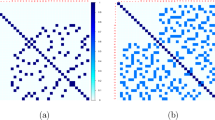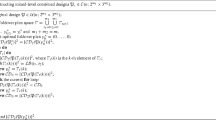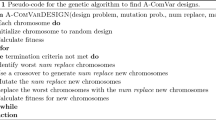Abstract
In this paper we consider screening experiments where m factors are to be studied using n experimental runs and where m is relatively large compared to n. In such experimental settings unreplicated fractional factorial (FF) designs are often used. Unreplicated FF designs have received a good deal of study over the past 15 years because they present problems in terms of use and analysis. One major problem with unreplicated FF design is the lack of reliable estimates for experimental error. Because of this a number of methods have been developed for identifying significant effects which include both graphical and more objective methods. However, there does not seem to be a clear winner among the methods suggested. In this paper we suggest as an alternative the use of partially replicated FF designs. The use of partial replication provides a non-model dependent estimate for pure error which allows for simpler and more standard methods for identifying significant effects through the use of F-and T-tests for lack of fit and individual contrasts. To illustrate the possibilities we focus on 16 run designs and provide some partially replicated designs for 4 ≤ m ≤ 11. We compare our proposed designs in terms of the A-optimality criterion and Estimation Capacity to regular unreplicated FF and Generalized Minimum Aberration non-regular FF designs. Our results indicate that partially replicated FF are competitive in terms of the criteria mentioned.
Similar content being viewed by others
References
Box GEP and Hunter JS (1961). The 2k-p fractional factorial design. Technometrics 3: 311–351
Chen J (1992). Some results on 2m-k fractional factorial designs and search for minimum aberration designs. Ann Stat 20: 2124–2141
Chen H and Hedayat AS (1996). 2n-m fractional factorial designs with (weak) minimum aberration. Ann Stat 24: 2536–2548
Chen J and Wu CFJ (1991). Some results on s m-k fractional factorial designs with minimum aberration or optimal moments. Ann Stat 19: 1028–1041
Chen J, Sun DX and Wu CFJ (1993). A catalogue of two-level and three-level fractional factorial designs with small runs. Int Stat Rev 61: 131–145
Cheng CS, Steinberg DM and Sun DX (1999). Minimum aberration and model robustness for two level fractional factorial designs. J R Stat Ser B 61: 85–93
Daniel C (1969). Use of half normal plots in interpreting two level experiments. Technometrics 11: 311–341
Deng L-Y and Tang B (2002). Design selection and classification for Hadamard matrices using generalized minimum aberration criteria. Tehnometrics 44: 173–184
Dykstra O (1959). Partial duplication of factorial experiments. Technometrics 1: 63–75
Fries A and Hunter WG (1980). Minimum aberration 2k-p designs. Technometrics 22: 601–608
Franklin MF (1984). Constructing tables of minimum aberration 2k-p designs. Technometrics 26: 225–232
Ghosh S and Tian Y (2006). Optimum two-level fractional factorial plans for model identification and discrimination. J Multivar Anal 97: 1437–1450
Hamada M and Balakrishnan N (1998). Analyzing unreplicated factorial experiments: a review and some new proposals (with discussion). Stat Sinica 8: 1–41
Hamada M and Wu CFJ (1992). Analysis of designed experiments with complex aliasing. J Qual Technol 24: 130–137
Hamada M and Wu CFJ (2000). Experiments: planning, analysis and optimization. Wiley, NY
Lenth RV (1989). Quick and easy analysis of unreplicated factorials. Technometrics 39: 463–473
Li W and Nachtsheim CJ (2000). Model robust factorial designs. Technometrics 42: 345–352
Lin DKJ and Draper NR (1992). Projection properties of Plackett and Burman designs. Technometrics 34: 423–428
Margolin BH (1969). Results on factorial designs of resolution IV for the 2n and 2n3m series. Technometrics 11: 431–444
Miller A and Sitter RR (2005). Folded-over non-orthogonal designs. Technometrics 47: 502–513
Pigeon JG and McAllister PR (1989). A note on partially replicated orthogonal main effect plans. Technometrics 31: 44–55
Plackett RL and Burman JP (1946). The design of optimum multi-factorial experiments. Biometrika 33: 305–325
Suen CY, Chen H and Wu CFJ (1997). Some inequalities on g n-m designs with application to minimum aberrations. Ann Stat 25: 1176–1188
Tang B and Deng L-Y (1999). Minimum G 2 aberration for non-regular fractional factorials. Ann Stat 24: 2549–2559
Tang B and Wu CFJ (1996). Characterization of minimum aberration 2n-k designs in terms of their complimentary designs. Ann Stat 24: 2549–2559
Wang JC and Wu CFJ (1995). A hidden projection property of Plackett–Burman designs. Stat Sinica 5: 235–250
Author information
Authors and Affiliations
Corresponding author
Rights and permissions
About this article
Cite this article
Dasgupta, N., Jacroux, M. & SahaRay, R. Partially replicated fractional factorial designs. Metrika 71, 295–311 (2010). https://doi.org/10.1007/s00184-009-0231-x
Received:
Published:
Issue Date:
DOI: https://doi.org/10.1007/s00184-009-0231-x




